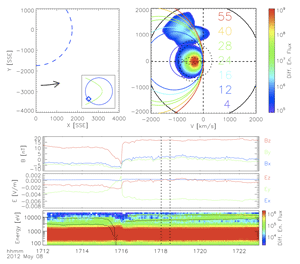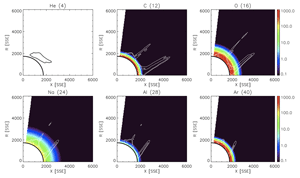2013 ARTEMIS SCIENCE NUGGETS
Utilizing ARTEMIS pickup ion observations to place constraints on the lunar atmosphere
by J.S. Halekas, U.C. Berkeley Space Sciences Laboratory
Introduction
Though we have known since the 1960s that the Moon has a tenuous atmosphere (or exosphere, given that the mean free path exceeds the scale height), its exact composition, structure, and dynamics remains poorly known. To remedy this gap in our knowledge, the LADEE (Lunar Atmosphere and Dust Environment Explorer) mission will launch in late 2013. Utilizing ARTEMIS observations of the ionized constituents of the lunar atmosphere, and forward modeling to constrain the source populations responsible for producing these pickup ions, we can now help pave the way for LADEE by placing new constraints on the composition and structure of the atmosphere that may assist LADEE in developing its observational strategy. This study also lays the groundwork for future collaborative observations, when ARTEMIS can observe the solar wind drivers of the atmosphere and the ionized escaping portion, and LADEE can observe the neutral atmosphere in situ and remotely.
Results
We present a method for deriving constraints on the structure and composition of the lunar atmosphere by utilizing pickup ion measurements from ARTEMIS, mapping observed fluxes from the spacecraft location to derive production rates at the source region, and fitting to a parameterized neutral atmosphere model. We apply this technique to ~12 minutes of high resolution burst data collected by ARTEMIS P2 above the sunlit lunar surface (See Fig. 1), in the dawnside terrestrial magnetosheath. During this time period, ARTEMIS observed multiple velocity components, requiring the presence of multiple species and/or source regions.
| Figure 1. Pickup ion observation by ARTEMIS in the terrestrial magnetosheath, showing the orbit of ARTEMIS, time series plots of magnetic and electric fields, ion energy spectra, and a sample ion velocity distribution with multiple components consistent with pickup ions in the mass range 12-40. |
We utilize species at or near masses 12, 16, 24, 28, and 40 to derive a best-fit model (see Fig. 2). This model proves reasonably consistent with known abundances and limits on neutral densities at masses 24-40, though recent LRO observations may reduce the limits on some of these neutral densities [Cook et al., 2013], possibly changing the most likely interpretation of the dominant species in each mass range.
| Figure 2. Best fit combined model for neutral atmospheric populations, assuming that the species listed above each panel produce the dominant contribution at each mass. The observed fluxes could instead come from other species or a combination thereof in this mass range, as long as the source population has a total production rate sufficient to produce the same final ion flux. Given the lack of coverage for He, we can place no firm constraints on the atmosphere in this mass range with this data set. |
Our model provides evidence for large neutral abundances at mass ~16, exceeding optical limits on neutral oxygen density by a factor of ~20 compared to limits published at the time this paper was written, and by a factor of ~2000 compared to recent limits from LRO [Cook et al., 2013]. This significant discrepancy could indicate that ARTEMIS is observing the transient effects of “seeding” of the Moon by terrestrial O during its magnetotail passage, consistent with the location in the dawnside magnetosheath. Alternatively, it could indicate the presence of significant contributions by OH or CH4, other species in the same mass range as oxygen. Either of these intriguing possibilities would have significant implications for the life cycle of solar wind elements at the Moon. A particularly exciting possibility is provided by the hypothesis that carbon-bearing molecules could comprise a significant portion of the lunar atmosphere, as hinted at by early measurements from Apollo LACE and theoretical predictions by Hodges [1976]. Carbon-bearing molecules could also contribute to the fluxes in the higher mass bins.
Conclusion
This work demonstrates the feasibility of using pickup ion measurements from orbit, even in the absence of detailed composition information, to place real constraints on the composition and structure of the lunar atmosphere. This particular observation had relatively unique characteristics, since the Moon was just completing its transit of the terrestrial magnetosphere. In the future, it should prove instructive to compare similar measurements at various lunar phases in order to determine the efficacy of various processes in producing the tenuous lunar atmosphere, and constrain the temporal and spatial variability of that atmosphere.
Reference
Cook, J.C., S.A. Stern, P.D. Feldman, G.R. Gladstone, K.D. Retherford, C.C. Tsang (2013), New upper limits on numerous atmospheric species in the native lunar atmosphere, Icarus, in press, doi: http://dx.doi.org/10.1016/j.icarus.2013.04.010.Halekas, J.S., A.R. Poppe, G.T. Delory, M. Sarantos, J.P. McFadden (2013), Using ARTEMIS pickup ion observations to place constraints on the lunar atmosphere, J. Geophys. Res., 118, doi:10.1029/2012JE004292.
Hodges, R.R., Jr. (1976), The escape of solar-wind carbon from the moon, Proc. Lunar Sci. Conf., 7th, 493-500.
Biographical Note
Jasper Halekas is an Associate Research Scientist at the U.C. Berkeley Space Sciences Laboratory. He has been studying the Moon since he was a graduate student, and is now a member of the DREAM2 SSERVI team, acting deputy PI of ARTEMIS, Guest Investigator on the LADEE mission, and a LEAG Executive Committee member. He is also currently preparing for the launch of MAVEN and starting development on the SPAN electron analyzers for the SWEAP suite on Solar Probe Plus.
 Please send comments/suggestions to
Emmanuel Masongsong / emasongsong@igpp.ucla.edu
Please send comments/suggestions to
Emmanuel Masongsong / emasongsong@igpp.ucla.edu

